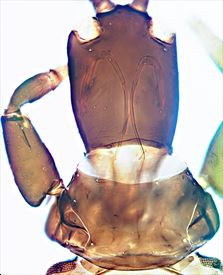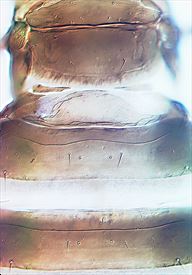Distinguishing features
Female fully winged. Dark brown; base of antennal segment III yellow; tarsi and apex of tibiae brown to pale brown; fore wings shaded with a dark, median longitudinal line; major setae brown. Head longer than wide, faintly sculptured on posterior margin; compound eyes much smaller ventrally than dorsally, directed forwards; 1 pair of finely acute postocellar setae; postocular setae finely acute; maxillary stylets broad, retracted to postocular setae; mouth cone rounded. Antennae 8-segmented, III with 2 sense cones, IV with 3; segment VIII lacking a distinct pedicel. Pronotum sculptured near posterior margin; major pronotal setae acute to bluntly acute, antero-marginal setae shortest. Pronotal epimeral sutures complete, basantra present; fore tarsal tooth absent in female. Mesopresternum transverse and reduced; metathoracic sternopleural sutures present. Fore wings with 5–8 duplicated cilia; major sub-basal setae acute. Pelta reticulate, with broad lateral lobes; tergites III–VI each with 1 pair of sigmoid wing-retaining setae, tergite II with a small, straight pair; tergite IX with posteromarginal setae acute, S1 about as long tube, S3 longer than tube. Female aptera similar in colour and structure to macroptera, but ocelli reduced or absent; mesopresternum absent; mesonotum broad, with 2 pairs of small setae laterally; metanotum also broad, lacking sculpture; tergites II–VII each with 1 pair of small, straight wing-retaining setae.
Male aptera similar in colour and structure to female aptera, but fore tarsal tooth present; fore femora swollen; pronotum elongate, with a longitudinal median apodeme; pelta with median lobe less pronounced; sternite VIII lacking a pore plate.
Related species
This species differs from Cryptothrips nigripes, the type species of this genus, in having the postocular setae arising behind the midpoint of each compound eye, rather than behind the inner margin, and the antennal segments are much more slender. It is also related to C. amneius from Australia, but that has the third antennal segment brownish-yellow in the proximal half, and the fore wing bears only two duplicated cilia.
Biological data
Feeding by imibing fungal spores, and living on dead branches; collected once from curled leaves of Acacia longifolia.
Distribution data
Known only from New Zealand (ND / SD, BR, CO).
Family name
PHLAEOTHRIPIDAE, IDOLOTHRIPINAE
Species name
Cryptothrips okiwiensis Mound & Walker
Original name and synonyms
Cryptothrips okiwiensis Mound & Walker, 1982: 22
References
Mound LA & Palmer JM (1983) The generic and tribal classification of spore-feeding Thysanoptera (Phlaeothripidae: Idolothripinae). Bulletin of the British Museum (Natural History). Entomology 46: 1–174.
Mound LA & Walker AK (1986) Tubulifera (Insecta: Thysanoptera). Fauna of New Zealand 10: 1–140.


